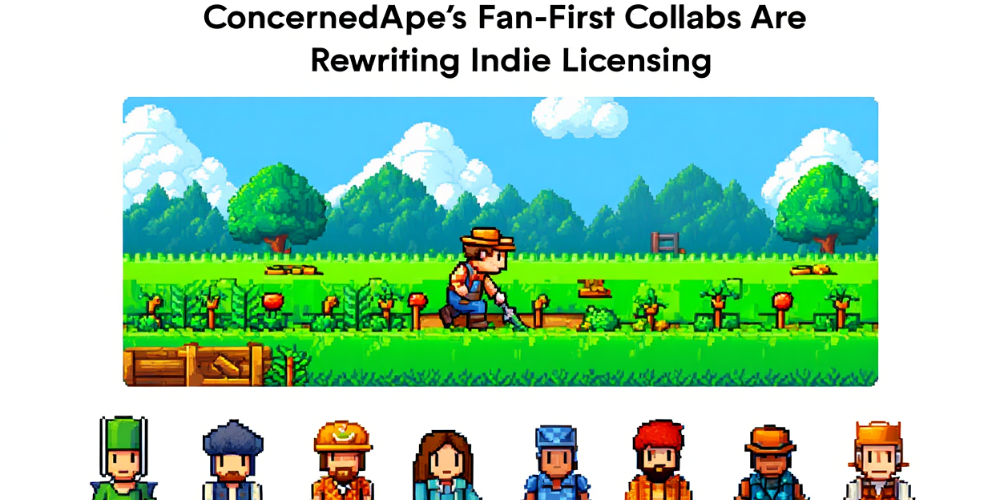ConcernedApe’s Fan-First Collabs Are Rewriting Indie Licensing
2025-08-25

There is something quietly radical about the way Eric Barone, better known as ConcernedApe, approaches the Stardew Valley universe he built. As reported by Eurogamer, the developer has explained that collaborations featuring Stardew Valley elements in other games aren’t a revenue play for him; he doesn’t charge fees, and he greenlights crossovers because they delight players. It is an unusual stance in a market where IP licensing typically involves minimum guarantees, intricate approvals, and revenue shares. Yet the context matters: Stardew Valley has sold tens of millions of copies worldwide and remains a cultural touchstone, recently reinvigorated by the 1.6 update that pulled lapsed farmers back to Pelican Town. That financial security gives Barone the latitude to prioritize goodwill over short-term payments. More than a feel-good headline, this policy signals a thoughtful philosophy about fan trust, creative control, and how indie powerhouses can nudge the industry toward more generous norms.
Main Part
To appreciate how unusual this is, consider the standard pipeline for crossovers. Typically, a studio pays to use another game’s characters, items, or aesthetics, often agreeing to tight brand guidelines, asset handoffs, and multi-stage approvals. The contract can include upfront fees, royalties, regional restrictions, and platform-specific carve-outs. Even when everyone means well, those constraints translate to costs that trickle down to players, whether through cosmetic microtransactions or bundled packs. Barone’s zero-fee posture strips out a significant layer of friction. Partner teams can allocate more budget to craft, and the end product can launch as a free update or a modestly priced add-on that feels like a celebration rather than a surcharge. The approach is also reputationally astute: instead of extracting value from nostalgia, it reinvests that goodwill into the community. Over time, that trust compounds into something harder to buy—an enthusiastic audience that amplifies every announcement with organic word of mouth.
There is discipline behind the generosity. Barone’s policy does not mean an open door to any pitch that lands in his inbox. By most accounts, he collaborates when the partner’s ethos aligns with Stardew Valley’s cozy, player-first spirit, when the cameo respects lore, and when the execution quality is clear from prototype to final pass. That means saying no to proposals that feel exploitative, scattershot, or overly transactional. In practical terms, even a free license still needs a sturdy agreement: scope definitions, asset usage terms, approval checkpoints, platform coverage, term lengths, and conditions around updates or delisting. The difference is that the negotiation centers on creative fit and community impact rather than squeezing for fees. Indie teams benefit from halo effects—discoverability, shared audiences, and press momentum—while players get crossovers that feel curated instead of promotional. The result is a form of cultural exchange that can lift multiple games at once without turning the moment into a cash register.
From the player’s perspective, the value is refreshingly tangible. Many fans are weary of nickel-and-dime cosmetics that turn cameos into receipts. When a crossover drops without a price tag or with clearly restrained monetization, it reads as a gift rather than a toll, and it invites players to celebrate instead of calculate. That tone fits Stardew Valley’s identity: communal, generous, gently nostalgic. It also sets a workable blueprint for other creators who have the runway to try it. Not every studio can waive fees—runway, payroll, and platform cuts are real constraints—but a few well-placed gestures can reset expectations and prove that positive-sum collaboration pays dividends in loyalty and reach. There are risks, of course: partners must resist overuse, and audiences can start expecting every crossover to be free. But Barone’s clear boundaries and measured cadence help keep the policy sustainable. When the intent is transparent and the craft is careful, players repay that respect with attention, patience, and lasting support.
Conclusion
Zoom out, and the lesson from Stardew Valley’s free-collab stance is surprisingly pragmatic. Value does not always flow through invoices; sometimes it travels through trust, timing, and taste. By declining fees, Eric Barone trades short-term licensing income for an asset that is harder to counterfeit: a community that believes him when he says the work is for them. That credibility shores up every future step, whether it is another Stardew patch, a new platform launch, or the long-anticipated Haunted Chocolatier. For developers, the takeaway is not a blanket call to forgo licensing revenue, but a prompt to recalibrate deals around fan delight, production quality, and respectful integration. For players, it is a reminder that some creators still orient decisions around joy rather than extraction—and that kind of stewardship is worth supporting. If more collaborations follow this lead, the industry will edge toward partnerships that feel like shared festivals instead of sales events, and that is a future many of us would happily cheer on.




Leave a comment
Your comment is awaiting moderation. We save your draft here
0 Comments